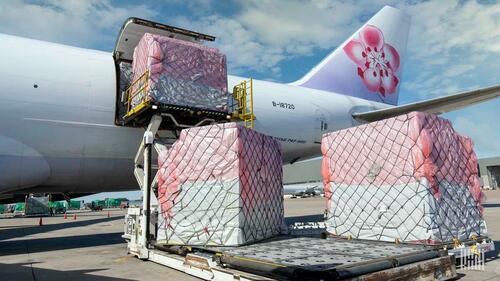
Air Cargo получил $22 млрд Доходы упали, когда в Китае закончилось освобождение от пошлин
Эрик Кулиш из FreightWaves
Планы США в следующем месяце по отмене беспошлинного доступа к поставкам малоценных посылок из Китая и Гонконга в сочетании с новой 145%-й тарифной ставкой на китайский импорт могут привести к потере более 22 миллиардов долларов дохода от сектора воздушных грузов в течение трех лет и вывести из бизнеса тысячи онлайн-продавцов с моделями выполнения заказов напрямую потребителям.

Дерек Лоссинг, основатель Cirrus Global Advisors, ранее заявлял, что недавние торговые действия администрации Трампа против Китая «определят» воздушные грузы из Китая, потому что спрос на продукты на платформах Temu и Shein упадет. Его консалтинговая компания в Сиэтле в настоящее время количественно оценила влияние изменений на сектор грузовых авиаперевозок.
Модель Cirrus Global Advisors показывает, что доходы отрасли авиаперевозок могут сократиться на 22 миллиарда долларов, если Белый дом сохранит тарифы на уровне 125% в течение значительного периода времени, основываясь на предположениях о более низком потребительском спросе, избыточной пропускной способности авиакомпаний и понижательном давлении на доходность. Ожидается, что крупные грузовые авиакомпании и экспедиторы, такие как Atlas Air и дочерняя компания Kuehne + Nagel Apex Logistics, с большим воздействием крупных китайских рынков, а также Amazon и небольших онлайн-брендов, будут испытывать понижательное давление на доходы.
Оценка была сделана до того, как США уточнили, что тарифная ставка в Китае на самом деле составляла 145%, чтобы включить предыдущий тариф, но неясно, будет ли более высокая ставка еще больше снижать доходы отрасли.
По данным поставщиков логистических услуг и Международной ассоциации воздушного транспорта, на долю поставок электронной коммерции приходится от 50% до 60% объемов воздуха в Китае и США и примерно 20% глобальных объемов воздушных грузов. Эксперты сходятся во мнении, что десятки широкофюзеляжных грузовых судов ежедневно перевозят грузы из Китая через Тихий океан, но, по его мнению, оценка в 100 таких самолетов нидерландским консультантом Ротате высока.
Общий доход от авиаперевозок на китайско-американской торговой полосе сократится более чем на 30% из-за более низких объемов, вызванных новой торговой политикой США, и более низких урожаев, которые последуют, прогнозирует Lossing.
Когда прошлой осенью администрация Байдена предложила ужесточить правила для подмножества китайских товаров, чтобы претендовать на de minimis, программу, которая позволяет беспошлинный и не облагаемый налогом ввоз отправлений с совокупной стоимостью 800 долларов США или менее на человека в день, Cirrus Global Advisors оценил влияние на глобальный доход от авиаперевозок в 3 миллиарда долларов в течение трех лет. Оценка потери доходов неуклонно росла с агрессивным позерством Трампа против Китая до и после его инаугурации, кульминацией которого стал полный запрет всех китайских товаров на беспошлинное обращение, вступивший в силу 2 мая. Начиная со следующей пятницы, розничные торговцы должны будут подать официальные таможенные записи, которые требуют гораздо больше информации и времени, чем процесс ускорения доставки.
Таможенная и пограничная охрана США говорит, что слабые требования к данным для поставок затрудняют проверку на ввоз незаконных и небезопасных товаров. Трамп отменил de minimis на том основании, что он позволяет контрабанду опиоидного фентанила и дешевый импорт, который подрывает розничные сети и производителей в США.
Ограничение минимальных тарифов, когда тарифы были относительно низкими, в основном считалось неудобством для крупных китайских рынков, таких как Temu, Shein и Alibaba, потому что их цены настолько низки, что потребители, вероятно, не изменят свои покупательские привычки, если предмет одежды вырастет в цене на 2 или 3 доллара. Но введение 145% тарифов взорвало модель выполнения заказов в Китае и доставки их по воздуху непосредственно в резиденцию клиента, что было дешевле и быстрее, чем доставка навалом по океану на склад США для сбора, упаковки и доставки.
Temu, чрезвычайно популярный рынок дешевых товаров, и бренд быстрой моды Shein на прошлой неделе уведомили клиентов на своих веб-сайтах, что они будут повышать цены с 25 апреля в ответ на новые правила торговли и растущие тарифы. South China Morning Post сообщила, что Temu уже резко сократила онлайн-рекламу в США Несмотря на это, на обоих сайтах в последнее время наблюдается всплеск заказов, поскольку покупатели пытаются получить товары до введения тарифов.
В дополнение к более высоким ценам от тарифов, цифровые рынки могут потерять продажи, поскольку новые требования к таможенному оформлению создают трения для клиентов во время оформления заказа.
«Насколько комфортно американским онлайн-потребителям будет предоставлять больше личной конфиденциальной информации для покупок на китайском веб-сайте, чтобы облегчить таможенную декларацию для отправки B2C», — написал он. Если проблемы с электронной коммерцией и конфиденциальностью не позволят потребителям завершить покупки, снижение объемов трансграничных посылок и доходов от авиаперевозок может быть даже больше, чем прогнозируется в настоящее время.
Модель Cirrus, как и другие, предполагает, что резкое падение поставок электронной коммерции в Китай в США значительно снизит спрос на грузовые самолеты. Авиакомпании будут реагировать ускорением выхода на пенсию старых самолетов и перемещением активов на другие рынки, что приведет к увеличению пропускной способности и снижению средних ставок фрахта. Степень, в которой экспресс-перевозчики и грузовые операторы сокращают расписание рейсов или удаляют самолеты из Китая, будет зависеть от того, насколько потребители откажутся от покупок.
И Если Еврокомиссия последует за намерением отменить исключение de minimis для товаров стоимостью менее 170 долларов США и ввести таможенный сбор за обработку отдельных пакетов B2C, ущерб для трансграничных игроков электронной коммерции, включая грузовые авиакомпании, может быть серьезным.
«Это своего рода один-два удара, которые потенциально могут привести к потере доходов от авиаперевозок по нашей текущей оценке», — сказал он.
И потенциальный ущерб для отрасли может распространиться, если администрация Трампа, как под угрозой, устранит преимущества de minimis во всех странах, как только будут созданы системы для сбора тарифов с миллионов дополнительных поставок в день. Но ущерб также может быть менее серьезным, если президент будет следовать схеме быстрого отмены политических заявлений и ослабит тарифы или правила de minimis.
Маленькие онлайн-продавцы с высоким риском
Репрессии в отношении китайских поставок электронной коммерции представляют собой экзистенциальную угрозу для многих небольших и средних электронных ритейлеров с витринами, продающими товары непосредственно из Китая, а также поставщиков логистики, которые обрабатывают таможенное оформление и доставку последней мили для грузоотправителей B2C.
Крупные китайские рынки уже готовились к более ограничительным правилам de minimis, построив миллионы квадратных футов американских складов за последние пару лет для поддержки более традиционной модели исполнения B2B2C. Например, Temu отправит товары в свою американскую организацию, очистит их через официальный таможенный въезд, оплатит пошлину и отправит их в центр исполнения, где они будут храниться, собираться, упаковываться и доставляться.
Еще одна причина консолидации воздушных или морских перевозок при одном таможенном ввозе заключается в снижении стоимости таможенных брокерских услуг и сборов за обработку товаров, выплачиваемых правительству за одну партию. Стоимость подачи заявок таможенными брокерами вырастет с 10 центов до 3 долларов США за пакет, как только будет устранен специальный путь de minimis.
Национальный совет по внешней торговле подсчитал, что без минимизации среднего пакета в 50 долларов потребуется около 31 доллара в бумажной работе, брокерская плата в 20 долларов плюс тарифы и налоги, что более чем удвоит стоимость доставки.
В дополнение к значительно более высоким затратам на импорт, ожидается, что для обработки CBP в рамках стандартного процесса ввода потребуется больше времени.
В Китае есть десятки тысяч небольших компаний, которые продают на Amazon и других платформах, которые не смогут заплатить 145% тарифа и не имеют ресурсов для использования традиционной контейнерной экспортной модели. И многие клиенты перейдут на такие страны, как Вьетнам, где тарифы ниже, для своих онлайн-заказов.
Он смягчил аргументы о том, что модель прямой к потребителю для электронной коммерции из Китая по-прежнему жизнеспособна, потому что она позволяет продавцам откладывать тарифы до фактического времени продажи по сравнению с оплатой их в порту въезда в США, и это позволяет избежать риска того, что наличные деньги будут привязаны к непроданным запасам при оплате складирования.
Связанный со ссылками Он оспорил заявление на Bloomberg Television, сделанное Иззи Розенцвейгом, генеральным директором логистического провайдера электронной коммерции Portless, о том, что выгоды от выполнения индивидуальных заказов из Китая жителям США по-прежнему имеют экономический смысл. Розенцвейг сказал, что у Shein есть большая маржа, чтобы поглотить более высокие затраты на импорт, в то время как цель Temu - выполнить 80% своих заказов в США.
«Существуют довольно значительные данные, которые показывают, что китайская модель D2C не выживет при таких тарифных ставках и закрытии de minimis. Думаю, только время покажет, что произойдет... Единственный плюс, который мы видим для модели электронной коммерции Китая и США, заключается в том, что тарифы на авиаперевозки снизятся на 30-40% на торговой полосе, в результате чего стоимость одной посылки снизится более чем на 1 доллар за единицу.
Аарон Рубин, основатель и генеральный директор ShipHero, поставщика программного обеспечения для управления складом для брендов электронной коммерции, сказал в LinkedIn, что FedEx взимает дополнительные 45 центов за фунт на авиаперевозках из Китая, потому что так много компаний проводят продажи, чтобы ликвидировать свои китайские продукты для минимизма истекает 2 мая.
Новые тарифы, более высокие тарифы на доставку и трения с клиентами вместе «заставят все компании создавать и внедрять модели клиренса B2B2C, потому что запрос конфиденциальной информации о клиентах при оформлении заказа является гвоздем в гроб».
Тайлер Дерден
Мон, 04/21/2025 - 21:25

















